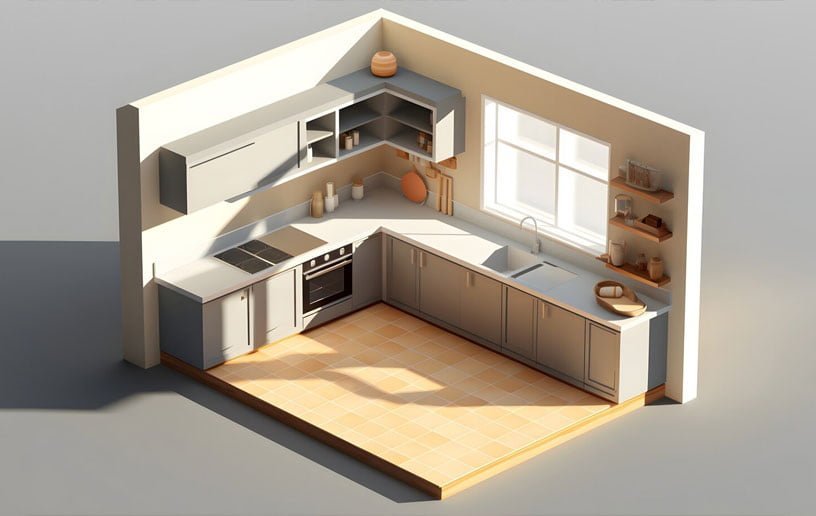Kitchen lighting is one of the most important elements of kitchen design. After all, the kitchen is the heart of the home. Proper lighting can make a kitchen feel warm, inviting, and functional. But how does one go about creating an effective kitchen lighting plan?
What is the purpose of proper kitchen lighting?
The goal of a good kitchen lighting plan is to make the space feel vibrant and livable. Lighting serves both visual and psychological purposes in the kitchen. Proper lighting allows you to easily prepare food, cook safely, and clean up messes. It also sets the overall mood of the room. The right lighting makes a kitchen feel welcoming and lively.
When designing a kitchen lighting plan, it is key to think about lighting on three levels: ambient, task, and accent. Balancing these three types of light creates an inviting kitchen atmosphere.
Understanding the Different Types of Kitchen Lighting
Ambient Lighting
Ambient lighting provides overall illumination to the entire kitchen. It is the general lighting that fills the room. Often, ambient kitchen lighting consists of ceiling lights. Pendants, chandeliers, and surface-mounted fixtures work well for ambient light.
The goal of ambient lighting is to wash the space in a soft, uniform light. It prevents shadows and makes the area feel bright and airy. Ambient lighting alone can feel flat and stark. It works best when combined with task and accent lighting.
Task Lighting
As the name implies, task lighting focuses light on specific kitchen tasks. Island pendants, under-cabinet lighting, and recessed cans create targeted task lighting. Cooks use task lighting to safely handle knives, read recipes, and see ingredients.
Proper task lighting prevents eye strain and kitchen accidents. It allows you to chop, cook, and clean with ease. Position task lighting over key kitchen zones like the sink, stove, and prep areas. Make sure it provides bright, shadow-free illumination.
Accent Lighting
Accent lighting adds drama to the kitchen’s decor. It creates visual interest in specific features, surfaces, or objects. For example, accent lighting can spotlight a beautiful backsplash, display case, or piece of wall art.
Common types of accent lighting include track lights, picture lights, and directional recessed lighting. Accent lighting draws attention to decorative details. It adds depth and dimension when combined with ambient and task lighting.
Designing an Effective Kitchen Lighting Plan
When designing a kitchen lighting plan, consider the room’s size, layout, surfaces, and color scheme. Here are some tips for creating a balanced lighting design:
- For a compact galley kitchen, use ambient recessed ceiling lights to prevent a cluttered look. Add task lighting over the sink and stove.
- In a spacious kitchen, make a design statement with a dramatic chandelier or pendant fixture for ambient light.
- For a kitchen with dark floors and cabinets, increase the wattage of the ambient and task lighting.
- In a colorful kitchen, accent lighting on the backsplash and display areas will make the colors pop.
- Layer multiple lighting types for a warm, inviting ambiance. Combine recessed ceiling lights with pendant task lighting and accent lighting.
The ultimate goal is to blend ambient, task, and accent lighting seamlessly. Vary the heights, locations, and intensity of the lighting. This creates depth and visual interest.
Choosing the Right Kitchen Lighting Fixtures
The lighting fixtures you choose impact the room’s style and functionality. Consider the finish, material, and mounting style of each fixture. Here are some popular kitchen lighting fixture options:
Pendant Lights
Pendant lights suspended over islands and dining areas provide both task and ambient lighting. Mini-pendants work well over a kitchen sink or stove. Larger statement pendants can serve as a dramatic design focal point. Match metals and finishes for a cohesive look.
Under Cabinet Lights
Under cabinet lighting illuminates countertops and backsplashes. LED strip lighting and low-profile fixtures are easy to install. Choose warm white or daylight-colored lights depending on the task. Under cabinet lighting facilitates food prep and clean-up.
Recessed Ceiling Lights
Recessed downlights (also called can lights) create ambient lighting. Adjustable trims allow you to direct the beam where needed. Recessed lighting works well for general kitchen illumination. Combine different sizes and beam spreads.
Track Lighting
Track lighting offers flexibility through directional accent lights. Use track heads to spotlight kitchen features. Rotate and aim individual lights to highlight art, shelves, or counters.
Layering Light for a Warm, Inviting Ambiance
Proper layering of lighting creates a welcoming kitchen vibe. Combine different lighting types at varying heights and intensities. Here are some layering techniques:
- Install recessed ambient lighting at the ceiling plane. Add drop pendants for task lighting over key zones. Use track lights or picture lights for accenting decor.
- Line upper cabinets with under-cabinet strips to illuminate the countertops. Use recessed cans for general overhead lighting.
- Hang a statement pendant over the dining table or kitchen island. Supplement with recessed downlights around the perimeter.
Vary the color temperature of the lights as you layer. Incorporate ambient warm white, bright white task lighting, and accent lighting. Use dimmers to control the mood and adapt to changing needs.
Additional Tips and Considerations
- Incorporate windows and skylights to maximize natural light during the day. Supplement with fixtures at night.
- Choose ENERGY STAR-certified LED lighting for efficiency. This helps reduce energy costs over time.
- Install dimmer switches on key circuits to adjust light levels for different activities.
- Consider hiring a lighting designer if the kitchen layout or lighting goals are complex. Their expertise can help maximize functionality and ambiance.
- Set a kitchen lighting budget beforehand. Compare costs of fixtures and installation.
Conclusion
An inviting kitchen lighting plan balances ambient, task, and accent lighting. Consider the room’s layout, surfaces, and decor when selecting fixtures. Layer lighting types for warmth and vibrancy. Recessed ceiling lights paired with island pendants and under-cabinet lighting create a welcoming kitchen space. With some thoughtful planning, you can design a kitchen lighting scheme that is beautiful, lively, and bright.
